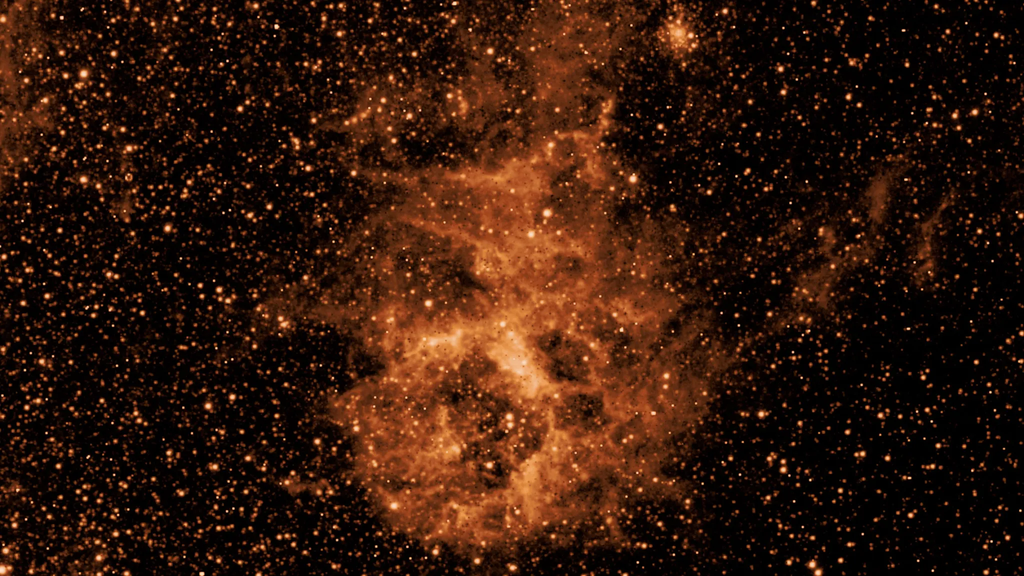SPHEREx Discovers Extended Carbon Dioxide Coma in Interstellar Object 3I-ATLAS
SPHEREx has made detailed multi-spectral observations of interstellar comet 3I/ATLAS, detecting an abundance of carbon dioxide gas in its coma (the extended gaseous atmosphere of a comet) and water ice in its nucleus. The observations were made between Aug. 8 to Aug. 12, when the object was about 290 million miles (470 million kilometers) from the Sun. This discovery highlights SPHEREx unique capabilities: its spectral resolution allowed us to clearly detect the CO2 emission, while its wide field of view enabled us to map the coma over scales extending 10 arminutes. SPHEREx published a brief Research Notes of the American Astronomical Society, and plans to release a more detailed publication soon.
The third interstellar object discovered to date, 3I/ATLAS originates from another star system and could be billions of years old. It was discovered on July 1 inside the orbit of Jupiter by the NASA-funded ATLAS (Asteroid Terrestrial-impact Last Alert System) survey telescope in Rio Hurtado, Chile. Studying the composition of interstellar objects like 3I/ATLAS can help us better understand the environment from which they were formed. Although further observations are needed to fully understand the interstellar object’s composition — many other NASA missions will be attempting to observe 3I/ATLAS as well — the discovery of an extended CO2 coma and the abundance of ice water shows that 3I/ATLAS may not be so different from the comets that formed around our Sun. Interstellar objects can provide scientists with a better understanding about the chemistry of star systems many light-years away.
Movie illustrating how SPHEREx observation tracked the 3I/ATLAS object. Movie frames are centered on the object and scan in wavelength across the CO2 line. The object moved appreciably throughout the observations. SPHEREx wide spectral mapping capability enables the detection of a very extended CO2 coma. Credit: NASA/JPL-Caltech.
The bottom two panels show SPHEREx 0.75-5.0 μm 2-pixel radius aperture spectrophotometry (left) and solar spectrum corrected reflectance (right) for 3I. Red arrows denote possible significant background contamination due to known background sources. The arrows start at the measured flux+1σ. For the reflectance, the NASA-IRTF/SpeX 0.7-2.5 μm spectrum (green) is overlaid. The two sets of measurements are consistent, and characterized by a slightly rising slope from 0.7-1.0 μm, a flat regime from 1.0-1.5 μm, a shallow absorption at 1.5 and 2.1 μm, and a strong falloff starting at 2.4 μm. The SPHEREx spectrophotometry stays low from 2.5-5.0 μm, with a huge uptick at 4.3 μm due to CO2 gas emission. Also overlaid for comparison is the average “cliff” KBO spectrum of Pinellia-Alonso et al. 2025 (pink). The top row shows, from left to right (1) Stacked 1.0-1.5 μm SPHEREx geometry- and Solar flux-corrected image of 3I. There is no significant extension found in the stacked image beyond a stellar point source in a SPHEREx 6.15” pixel. (2) SPHEREx 3.0/4.26/4.7 μm H2O/CO2/CO gas coma. The object is undetected in H2O and CO. By contrast, a bright CO2 coma that extends out to at least 30-pixel (=348,000 km) was found. Credit: NASA/JPL-Caltech.
Recent News
NASA’s newest astrophysics space telescope launched in March on a mission to create an all-sky map of the universe. Now settled into low-Earth orbit, SPHEREx (Spectro-Photometer for the History of the Universe, Epoch of Reionization, and Ices Explorer) has begun delivering its sky survey data to a public archive on a weekly basis, allowing anyone to use the data to probe the secrets of the cosmos.
Read MoreBuilding SPHEREx in a Caltech Basement
How a NASA space telescope came together in a university lab
Read MoreAfter weeks of preparation, the space observatory has begun its science mission, taking about 3,600 unique images per day to create a map of the cosmos like no other.
Read MoreNASA’s Newest Space Telescope Recognized at New York Stock Exchange
The SPHEREx astrophysics observatory will help answer big questions about the origins of our universe, of galaxies, and the ingredients for life in our galaxy.
Read MoreNASA’s SPHEREx Team To Ring New York Stock Exchange Bell
Members of the team behind NASA’s newest space telescope will ring the New York Stock Exchange closing bell in New York City at 4 p.m. EDT on Tuesday, April 22. The team helped build, launch, and operates NASA’s SPHEREx (Spectro-Photometer for the History of the Universe, Epoch of Reionization and Ices Explorer) mission to explore the origins of the universe. The New York Stock Exchange will...
Read More




